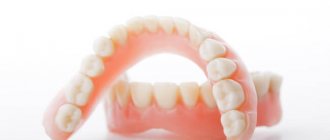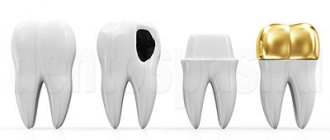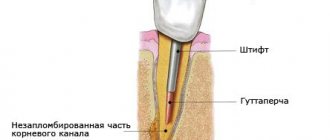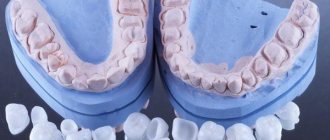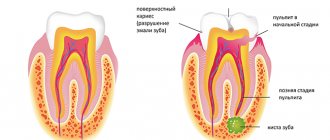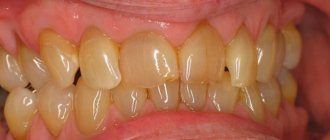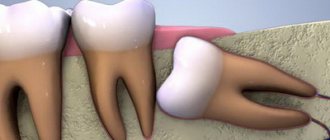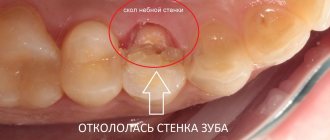June 15, 2019
Many patients are interested in the question of how to remove a crown from a tooth, because essentially the structure is permanent. However, this just means that the owner himself cannot remove it from the mouth, but the dentist, using tools and specialized equipment, will do this without difficulty. Today you will learn about how this process goes, by what methods the final result is achieved, what nuances await patients during the procedure of removing a crown from a tooth from an article prepared by journalists from the editorial office of the UltraSmile.ru portal.
What are the ways to remove a crown?
When is it necessary to remove a crown from a tooth?
Removing the crown from a tooth needs to be done only when there is a serious need for it, because the crown itself can be used for 7-10 years or more (the time period depends on the material from which the prosthesis was made).
Let us list the reasons why it is necessary to resort to such manipulation:
- a disease has developed under the structure: for example, secondary caries, periodontitis or a cyst,
- errors made at one of the stages of prosthetics: perhaps the crown does not correspond to the individual characteristics of the patient, is poorly installed and adjusted, is made of low-quality materials,
- the patient’s desire to replace the structure with a prosthesis made of a better and more beautiful material: for example, replace a metal or metal-plastic product with metal ceramics or zirconium dioxide,
- injuries that led to damage and breakage of an artificial tooth,
- destruction of permanent cement on which the orthopedic structure was fixed,
- The product has expired.
The reason for removal may be the development of caries under the crown.
If the tooth under the crown hurts, there is a bad smell, and the structure has become shaky and movable, then it is time to visit a dentist, who, based on an examination and x-ray, will decide on the need to remove and replace the artificial material.
According to numerous studies, the need to prematurely remove crowns already in the first years of use in 40% of all cases arises due to the fact that poor-quality endodontic treatment and poor-quality sanitation of the oral cavity were performed before preparing for prosthetics.
All of the above reasons are a serious reason to think about removing the prosthetic structure. Naturally, first you need to go to an appointment with a dentist, who will explain how crowns are removed from teeth. And we will look at the methods that exist today.
WHY DO YOU NEED TEMPORARY CROWNS?
Usually, before installing a crown or prosthesis, the tooth needs to be ground, and only after grinding can impressions be taken and the manufacture of dentures begin. A ground tooth looks very unsightly and causes both aesthetic and psychological discomfort to the patient. To restore the aesthetics and functionality of the dentition, temporary, or provisional, crowns are used. They are especially relevant for the front teeth. However, plastic crowns not only mask visual defects in the dentition. They perform several more very important functions: • Temporarily restore the function of a ground tooth; • Allows you to maintain normal diction; • Do not allow infection to enter the tissues of the prepared tooth; • Prevent gum tissue from growing onto the tooth to ensure normal installation of a permanent crown; • Allow a person to quickly get used to a permanent crown; • Firmly fix the tooth and prevent it from moving to the sides or staggering; • Maintains bite, preventing neighboring teeth from taking up free space; • If a tooth is ground down without removing the nerve, it becomes very sensitive to temperature and chemical stimuli, which can cause pain. A temporary crown protects such a tooth.
Method No. 1: sawing with a boron
So, let's figure out whether it is possible to remove a crown with permanent cement.
The method of removal using boron is the oldest and by far the most unaesthetic. This means that after using this tool, the sawn artificial material will only have to be thrown into the trash bin, because it can no longer be used for its intended purpose, that is, it will no longer be possible to re-prosthetize a tooth with it.
The technique is simple, cheap and quite effective, but it must be used by a doctor who has a high level of professionalism, because the approach requires caution and precision. An inexperienced specialist may damage the tooth itself or the soft tissue around it during the dismantling process.
With this method, it will not be possible to reuse the crown
“We removed the crown from the tooth with a regular bur and simply sawed it in half. There’s nothing terrible, but when the material got very hot, the smell, I’ll tell you, was not very good, plus there were slightly painful and uncomfortable sensations, even despite the fact that I had been given anesthesia before this, and the tooth itself had been under the prosthesis for a long time depulped!"
Mari, review from 32top.ru
This method is used if the patient has dentures made of inexpensive materials, which he would not mind disposing of later. The method is also suitable if the artificial structure itself is mobile or wobbly. Then it is simply sawed to the teeth, then, using special tools, the resulting edges are carefully bent in different directions and removed.
What is the best material for prosthetics?
The material is selected based on the design features, the patient’s age and the number of missing teeth in the mouth. Medical contraindications are also taken into account, which are determined before the production of prostheses. Valuable recommendations:
- Fixed dentures are made of ceramics, metal-ceramics, aluminum oxide and zirconium dioxide. The materials are highly biocompatible, attractive due to their quick adaptation in the mouth, strength and wear resistance. When compared to natural teeth, they are indistinguishable.
- Partially removable dentures. Such structures are attached to your teeth and gums; they are best used for small gaps in the jaw. Choose acrylic, acryfree, nylon as a reliable material. Clasp designs are also popular.
- Removable dentures. They are fixed with cream or special suction cups to the jaw. As for materials, give preference to nylon, metal-plastic, plastic (for the base); nylon, polyurethane, acrylic (for the crowns themselves).
Category Dentures Published by Mister stomatolog
Method No. 2: using ultrasound
Are you wondering how to remove a crown from permanent cement in one of the safest and most innovative ways, and without causing any damage to it? Then ask your dentist if it is possible to use ultrasound in your case. Through impulses, the doctor acts on the cement composition, which gradually cracks. The specialist moves along the “tooth-crown” boundary; under the influence of vibrations, the cement is destroyed.
The product can be removed using ultrasound
The procedure really allows you to remove the structure in its original form, but it has a number of disadvantages. First, ultrasound has a rather gentle effect, so it is not always possible to achieve the goal the first time, and sometimes you have to visit the doctor several times. Secondly, only products that are made from not very dense materials are amenable to hardware exposure to sound waves. For example, it will not be possible to remove structures made using glass ionomers using ultrasound. Third, vibrations may be unpleasant for the patient.
Method No. 4: Kop (Koch) apparatus
This is a tool that again has a hook at the end. However, the device is not launched mechanically, but using a button, which breaks the cement along the edge of the crown using small shocks or a shock wave, after which the structure begins to move from its place. Next, the doctor can only use special forceps that hook and help to finally remove the prosthesis.
See what the Koch apparatus for removing crowns looks like in the photo.
This is what the Koch apparatus for removing crowns looks like
This device is more convenient and efficient than a manual device; it allows you to remove the product with virtually no damage and “works” quickly. However, it also has disadvantages. In particular, many patients note that during the procedures they feel “twitching” and discomfort. Also, some people are very concerned about the noise that the device makes. There is one more drawback - the device can damage the ceramic coating of the crown, leaving chips and cracks, and then the structure will have to be restored.
Method No. 5: using the Coronaflex device
The device looks like a pistol, and its operating principle is based on compressed air, which escapes from the device under pressure and breaks the cement. At the same time, this device does not have any negative effect on the artificial material of the structure or on the soft tissues of the patient.
The Coronaflex device is not available in every dentist today, so the procedure with it will be more expensive compared to other methods. However, it makes sense to use the device if you have a zirconium dioxide crown, which can be reinstalled after, for example, the tooth under the structure is cured. In addition, the procedure using this device is more comfortable, safer, and requires less time to solve the problem. Also, according to patient reviews, the device makes virtually no noise, which allows you to feel comfortable in the dentist’s chair.
The Coronaflex device removes the crown quite comfortably
MANUFACTURING TEMPORARY CROWNS
There are two main methods for making temporary crowns.
DIRECT METHOD
In this case, the temporary structure is made directly in the dentist’s office, and it takes no more than an hour: 1. First, the doctor makes an impression using silicone mass; 2. The tooth is prepared to the required size; 3. The dentist pours plastic into the prepared impression and then puts it on the tooth stump; 4. When the plastic hardens, the impression is taken, and the plastic structure remains on the tooth; 5. Using a frieze, excess material is ground off the temporary crown, and then it is ground and polished; 6. The finished crown is fixed on the tooth stump using temporary cement.
INDIRECT METHOD
The essence of this method is that the temporary crown, like the permanent one, is made in the laboratory. The impression is also taken with silicone mass, but then modeling takes place first with plaster and then with wax, and only after that the technician makes the crown itself. This method undoubtedly takes longer, but it allows you to make a temporary prosthesis more accurately, in accordance with the anatomical features of the jaw. In addition, such crowns are stronger and more reliable. Regardless of the material of the crown, it will be fixed with temporary cement. This cement is quite strong, but gradually dissolves under the influence of saliva. As a result, removing the temporary crown will not be difficult at all.
Is it possible to remove a crown at home?
If you are interested in the question of how to remove a crown from a tooth at home, then the answer will be clear: you cannot do this at home. This procedure should only be performed by a professional dentist. For those who neglect this rule, everything can end sadly: there is a risk of damaging not only the artificial material, but also injuring the soft tissues and the tooth itself, which is located under the crown.
You can try to remove the structure yourself only if it has come unstuck and started to loosen, or if it has fallen apart or split, and there is a need to remove the remaining fragments of the product, which can injure the mucous membrane or antagonist teeth. But it’s better if you rush to see a dentist even in such situations.
If the structure comes unstuck, you can remove it yourself
If the materials from which the crown was created, as well as the cement, have expired, and you do not rush to the dentist, then an unpleasant situation may await you. For example, artificial material can be swallowed. What to do in such situations, read the material “5 useful tips for those who have swallowed a crown.”
HOW TO CARE FOR A TEMPORARY CROWN
There are several rules for caring for temporary crowns so that they serve you until you are replaced with permanent ones: • Temporary cement is not very strong, so do not eat sticky and viscous foods - they can peel off the crown; • Try to chew less where the crown is installed; • Brush your teeth gently, especially around the temporary crown.
If the temporary crown falls out, you should contact your dentist as soon as possible to have it re-fixed. It is not recommended to sleep with a loose temporary crown in your mouth - you may accidentally swallow it.
Is it possible to cure a tooth without removing the crown?
The question is very relevant, because usually, after removing a structure, it can rarely be reused for its intended purpose, therefore, you have to pay money for the manufacture and installation of a new prosthesis. Fortunately, today in some cases you can do without removing the structure. For example, if it is necessary to cure recurrent caries or remove a small cyst, the doctor may perform endodontic manipulations through a small hole made in the crown or through an incision in the gum (to remove the cyst). After the procedures, this hole will be masked with a composite material, and the sutured gum will need time to heal.
In some cases, modern technologies make it possible to cure a tooth without removing the crown.
However, you need to understand that in order to safely and effectively carry out such jewelry manipulations, the doctor must be a professional. In addition, the patient himself should seek help when the problem is still minor and the inflammatory process has not gone too far. To do this, it is necessary to undergo preventive examinations, because the more minor the problem, the easier it is to solve it with therapeutic methods, without resorting to drastic measures.
Notice
: Undefined variable: post_id in
/home/c/ch75405/public_html/wp-content/themes/UltraSmile/single-item.php
on line
45 Notice
: Undefined variable: full in
/home/c/ch75405/public_html/wp-content /themes/UltraSmile/single-item.php
on line
46
Rate this article:
( 3 ratings, average: 5.00 out of 5)
crown
- Lutskaya I.K., Zinovenko O.G. Frequency of development of caries in teeth covered with artificial crowns.
Consulting specialist
Litvinenko Olga Viktorovna
Doctor rating: 10 out of 10 (2) Specialization: Dentist-therapist, orthopedist Experience: 21 years
Comments
Good afternoon. My metal-ceramic bridge on one tooth became movable. It is possible to remove the bridge without damage in order to reuse it. Thank you.
Svetlana (06/18/2019 at 11:25 am) Reply to comment
- Dear Svetlana! As a rule, no, the bridge is completely removed (you need to saw it). In addition, it is fixed on at least 2 supporting teeth, which apparently have become unusable.
Editorial staff of the portal UltraSmile.ru (06/21/2019 at 12:23 pm) Reply to comment
Tell me, how do you remove the crown from the implant?
AlinaR. (06/22/2019 at 17:29) Reply to comment
- Dear Alina! There are two extraction methods here, and which one to use will depend on how the crown is attached to the implant. If the fixation was screw (which is more preferable), then the doctor will simply unscrew the screws connecting the crown, implant and abutment. If the fixation was cement, then the specialist will use the cutting method - others are not suitable for implantation.
Editorial staff of the portal UltraSmile.ru (06/25/2019 at 09:19) Reply to comment
Which doctor should I go to to have my crown removed?
Makar (06/30/2019 at 10:02 pm) Reply to comment
- Dear Makar! This manipulation should be performed by an orthopedic dentist.
Editorial staff of the portal UltraSmile.ru (07/03/2019 at 09:17) Reply to comment
Is this procedure, removing a crown from a tooth, painful?
Arfa (07/18/2019 at 04:47 pm) Reply to comment
- Good afternoon This procedure cannot be called pleasant and comfortable, but it is painless, because... the doctor applies anesthesia. In addition, in most cases, crowns are used to replace already pulpless teeth that do not have a nerve. Pain and discomfort can only occur if inflammation has begun under the crown. Then pain can be felt not only in the tooth itself, but also in the soft tissues surrounding it.
Editorial staff of the portal UltraSmile.ru (07/26/2019 at 09:33) Reply to comment
Will my tooth hurt after the crown is removed?
Vedeneeva Victoria (05.08.2019 at 19:05) Reply to comment
- Dear Victoria. A tooth can only hurt if it has developed periodontitis or granuloma. Less often, pain occurs because the crown removal procedure was carried out by a not very professional doctor, who could injure the gums or mucous membranes, or damage the tooth itself.
Editorial staff of the portal UltraSmile.ru (08.08.2019 at 09:25) Reply to comment
Tell me, what if the crowns do not fit tightly to the gums on the back side, where is the palate? is this normal? that is, the tricrowns on the right entered the cast gums; three crowns _and the other three on the back side I feel their edges with my tongue….
san (01/09/2021 at 04:13) Reply to comment
Write your comment Cancel reply
Dental crowns are the most popular prosthetic option
A crown is placed on a tooth in the following cases:
- if an extensive carious process develops;
- if the cause of tooth decay was trauma, but its root is preserved;
- when the color of teeth changes or in the presence of other defects;
- in case of loose teeth, the cause of which is periodontal disease (temporary crowns can be placed to give the teeth stability);
- with pathological abrasion of enamel;
- in case of installation of a bridge structure (it can be fixed on healthy abutment teeth).
Now let's talk about how to install a crown on a tooth. This procedure involves several stages.
1. At the first stage, preparatory actions are carried out, including drawing up a treatment plan and considering possible prosthetic options. Depending on the results of x-rays and the clinical case, the doctor chooses the type of construction. Next, a treatment plan is drawn up, on the basis of which the dentist will act in the future. It may contain the following list of procedures:
- removal of non-viable teeth;
- preparatory operations for installing crowns;
- determination of the type of crowns in agreement with the patient;
- if a bridge is being installed, the number of supporting teeth required to fix it is specified;
- the cost of prosthetics is calculated;
- The timing of the production of crowns and their fixation is being clarified.
Before installing a crown, the tooth is treated and prepared (turning and depulping).
When depulping, the following actions are carried out:
- the nerve is removed;
- carry out instrumental treatment, as well as expansion of root canals;
- The canals, as well as the crown part of the tooth, are filled.
Next, the doctor restores the tooth crown, which can be done in two ways.
- Restoration using a pin. When using this method, a pin is screwed into the sealed canal of the root part of the tooth, after which a crown from the filling material is restored on its basis. Then the tooth is ground.
- Restoration using a stump tab. The inlay consists of crown and root parts, and is made in a dental laboratory. Fixation of the root part is carried out in the root canal, while the coronal part is already ready for fixation of the structure. Restoring a tooth using a stump inlay is a more reliable method that ensures a long service life.
During preparation, the tooth is ground with a diamond bur, giving it a special shape. The crown is subsequently fixed on the stump tab remaining after turning.
2. The second stage is laboratory. Impressions are taken after preparing the teeth for installation of the prosthesis.
- Using impression mass, impressions are taken from already ground teeth.
- The laboratory then makes plaster models of teeth based on existing casts.
- Next, the crowns are made using plaster models.
3. At the third stage, crowns are tried on and then fixed. Fitting is necessary to assess the quality of the crown frame and clarify the shade of the structure. Fixation is carried out using special cement, and temporary cement is used first.
The cost of installing a crown on a tooth is determined by the material used, the method of its manufacture, the status of the clinic and the professionalism of the dentist.
In some cases, it is necessary to remove crowns from teeth. The reasons for this may be:
- poor tooth preparation;
- errors in the manufacture of the prosthesis;
- planned replacement of crowns;
- structural damage;
- complications, which include significant pressure of the prosthesis on the gum tissue, caries of supporting teeth, allergies to materials used in the manufacturing process of the prosthesis.
The price of removing a crown from a tooth is determined by the complexity and labor intensity of the work and, as a rule, varies widely.
Our clinic deals with all types of prosthetics, including the installation of crowns and bridges, doing it efficiently, quickly and inexpensively.
Stock
-13%
Removable overdenture on 4 implants RUB 150,000.
130,000 rub.
get -6 %
BASAL COMPLEX - Restoration of teeth on 1 jaw in 3 days 265,000 rub.
250,000 rub.
get -37 %
Osstem dental implant and metal-ceramic crown RUB 63,000.
40,000 rub.
get -6 %
BASAL COMPLEX - Restoration of teeth on 1 jaw in 3 days 265,000 rub.
250,000 rub. get
